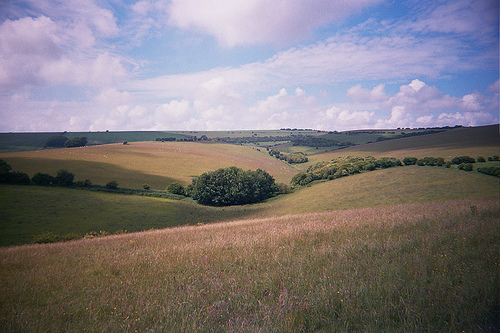Cathy pointed out an episode of Horizon that was on the BBC recently, discussing the science behind the human/dog relationship:
We have an extraordinary relationship with dogs—closer than with any other animal on the planet. But what makes the bond between us so special? Research into dogs is gaining momentum, and scientists are investigating them like never before. From the latest fossil evidence, to the sequencing of the canine genome, to cognitive experiments, dogs are fast turning into the new chimps as a window into understanding ourselves.
If you’d asked me what I thought about the whole dog ownership thing, I’d have said that there’s no real understanding going on (that is, on the dog-side of the relationship). I’d have guessed that dogs are manipulating us into handing over the next treat, meal or bit of affection by a cute ability of making us think they understand what’s going on. It’d be an illusion I’m happy to go along with because of the very tangible benefits. But it looks like I was wrong, and there’s some science pointing towards there being real understanding and communication.
Here are the notes I made:
On dogs understanding humans: the left gaze bias (Daniel Mills, University of Lincoln). Our facial expressions are not symmetric. When you look at a face you focus on the left (the person’s right) side of the face first, possibly because the left may be a better indicator of emotional state [citation needed]. This left gaze bias was thought to be unique to humans, but dogs also do this when looking at our faces, and they do it only when looking at human faces: not dog faces, not other objects. No other animal is known to do this.
The thinking is that detecting human state (e.g., anger) would be advantageous to dogs given that they live in close proximity to us.
On humans understanding dogs: barking (Adam Miklosi, Eötvös Loránd University, Budapest). In audio tests that involve playing dog barks to humans, people tend to agree on what a dog bark means, and are generally correct in their interpretation. Given that dogs are evolved from wolves, who don’t really bark, the suggestion is that barking developed specifically as a way for dogs to communicate to humans.
Bonding (Kerstin Uvnäs-moberg, Karolinska Institute, Stockholm). When a (human) mother breast-feeds her child she gets a hit of oxytocin, a hormone that helps the mother quickly bond to the baby. Blood samples taken from dogs and dog owners before and during a petting session show that both human and dog get a similar hit. The effect is a lowered heart rate, lower bloody pressure, reduced stress.
Dog behaviour: smart or just mimicking? (Juliane Kaminski, Max Planck Institute). “[…] in certain ways dogs may think more like us than any other animal, including our nearest relative the chimpanzee.” For example, dogs can understand pointing, which chimpanzee do not, and they can even follow our gaze. Again, these are abilities dogs do not use with each other—just for use with humans. Puppies seem born ready to communicate with humans.
Nature or nurture? (Kubinyi Enikö, Eötvös Loránd University). What happens if you try to raise wolf cubs in the same way you raise dog pups? Differences in wolf behaviour compared to dog behaviour become evident at 8 weeks (e.g., no interested in human activities, no eye contact, conflicts, destructive behaviour). The conclusion is that the dog is not a “socialized wolf”: it’s a selective breeding thing.
There were plenty of other interesting features in the programme, so go watch it. It’s available on iPlayer until early in April 2010.
